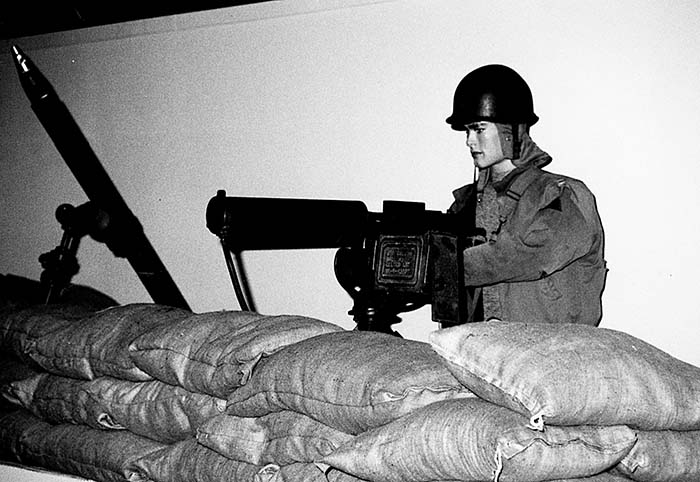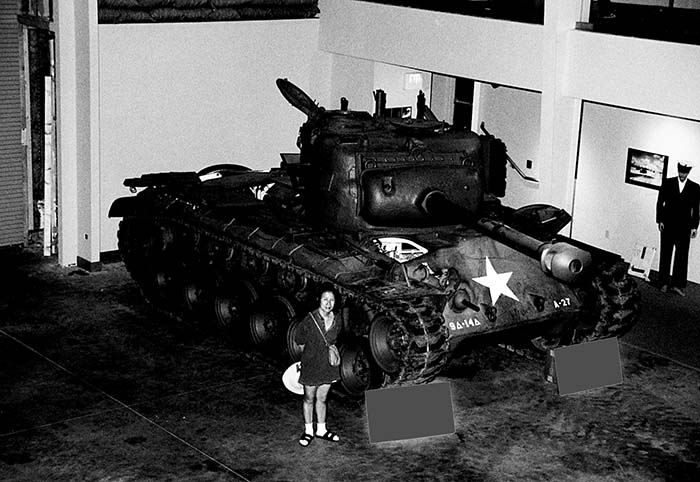By Robert M. Hausman
The Wright Museum of American Enterprise located in Wolfeboro, New Hampshire divides its focus between civilian and military life during the war years of 1939-1945. The military side is based on founder David M. Wright’s collection of about 40 U.S. military vehicles. The civilian focus is on Home Front activities taking place in support of the armed forces during the war.
“Our intention is to preserve that period of time when the U.S. industrial output was at its peak. Everyone pulled together during the war years and we not only attained victory, but also produced some very good industrial and military products. The whole idea behind this museum is to preserve that period when American-produced goods were tops in the world. We also present a slice of what daily life was like during the war years,” Wright says.
The museum showcases Americans’ enterprising spirit as the populace set aside their differences and answered the calls to arms of World War Two. The exhibits comprise an historically accurate collection of memorabilia, small arms, vehicles, period films and other artifacts intended to demonstrate the efforts the American people brought to this time of crisis. How daily civilian life changed, such as the entrance of women into the workforce and the migration of farmers to cities to work in factories, is portrayed through lectures, plays and motion pictures.

The museum site comprises six acres of land and contains about 32,000 square-feet of exhibit space within two buildings. The front building contains an arresting display of an American World War Two-era tank seemingly bursting through a brick sidewall onto the street. Inside, Big Band and other period music plays in the background as the visitor walks through the exhibits. Vegetables grown in an on-site Victory Garden are donated to a local foodbank.
Former members of the Women’s Airforce Service Pilots (WASPs) are honored by what Wright calls “the largest WASP exhibit in the country.” WASPs were not allowed to fly in combat but served by delivering fighter aircraft from factories to military bases, and helping to train male combat pilots.
Another exhibit honors the late René Gagnon, a New Hampshire Marine and Medal of Honor winner depicted in the famous wartime photograph and later sculpture of the World War Two Iowa Jima flag-raising.
Girl-power on the Home Front became America’s wartime strength, the museum exhibits detail. By 1944, there were 18.7 million more people at work in the U.S. than in 1939 and they were producing 40% of the world’s armaments. By July of 1945, the U.S. had built close to 300,000 aircraft, 71,000 Navy ships, 600,000 Jeeps, and 102,000 tanks.

With raw materials badly needed for the fabrication of arms, Americans formed the largest scrap drives in history. Tons of tires, toothpaste tubes, aluminum pots and tin cans piled into armament plants. For example, one old automobile radiator was said to provide the raw material for the production of seventeen .30 caliber rifles. One shovel could be converted into four hand grenades and 12 gas masks could be made from one old rubber tire. Rationing spread through the nation making shoes, food, liquor, cigarettes and especially gasoline, available only through a point system.
In keeping with the World War Two-era practice of volunteerism, a network of about 60 volunteers help to keep the institution running. Operational vehicles within the collection appear in local parades. The centerpiece of the collection is a T-26 Pershing tank which was among the first 20 such armored vehicles sent to Europe as part of the “Zebra” mission in February 1945. The detail, which was composed of the Ninth and Third Armored Divisions, each received 10 tanks. The museum’s specimen had been assigned to Company A, 14th Tank Battalion of the Ninth Armored Division and was one of the only known surviving tanks which crossed the Rhine River.
Open seven days a week during the summer, the museum opens its doors on weekends only during the winter months. Lake Winnipesaukee, a popular summer resort, is just a short distance away. For more information call (603) 569-1212.
| This article first appeared in Small Arms Review V2N1 (October 1998) |











